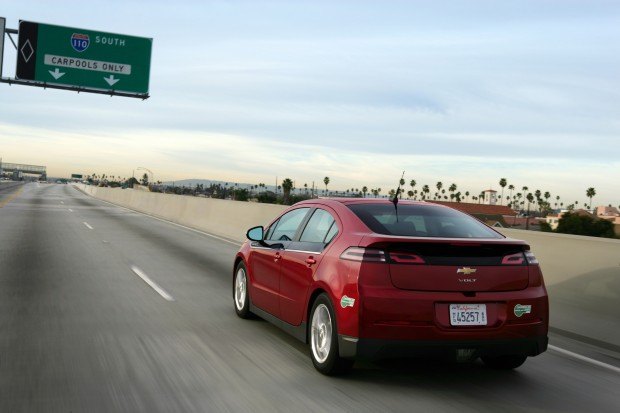Tales From The Cooler: California Plug-in Owners Pass on HOV Passes
The State of California is concerned that less than 3,800 Chevrolet Volt and Prius Plug-In hybrid owners have applied for Car Pool Lane stickers as of August 3. With these green decals affixed to their cars, owners of these two automobiles may drive with no passengers along the state’s 1,400 miles of HOV lanes.
Sacramento forecasted that 40,000 of the $8 decals would be purchased by plug-in pilots during this three-year program that began in January. The poor sales are partially due to the fact that consumers are not buying the two “Advanced Technology Partial Zero Emission Vehicles,” as California calls them, at a volume anywhere near the state’s forecast.
In March, California took action to pump up the disappointing sales of the vehicles, which boast a base MSRP of $32,000 for the Prius and $39,145 for the Volt. The state’s reaction was to offer a $1,500 consumer rebate for each car sold. They also tried to create a car dealer-like sense of urgency by stressing that the incentive funds were “limited.” Go See State of Cali Worthington Toyota/Chevrolet for Hot Hybrid Deals Today! Sales of the Volt immediately rose from 143 cars per month to around 450 per month. Sales of the Prius Plug-In are estimated to be around 600 per month in California.
Drivers may be declining the decals for two reasons. Even though these vehicles are electric/gas hybrids, their owners may be avoiding the freeways due to what has been deemed “Range Anxiety,” the fear of running out of electricity before trip’s end. (This is not to be confused with “Range Rover Anxiety,” the fear of electrical components failing before trip’s end.) With California’s legendary Sig Alerts backing up all lanes of a freeway, drivers face the real possibility of depleting their wattage and becoming stranded on the San Diego Freeway or the Oakland Bay Bridge. This scenario assumes plug-in owners will motor around with little or no gasoline in their tanks, which appears to be a likelihood according to “green car” message boards.
The second factor is California’s treatment of the first generation of “clean air” car owners. In July 2011, the state pulled the plug on 85,000 Low Emission Vehicles’ access to HOV lanes, citing they had achieved their goal of encouraging consumers to buy high-mileage cars. People are still upset about the state not extending the program and may be in fear of getting burned again.
It will be interesting to see California’s next move to jump start plug-in car pool lane usage. Maybe they will relent and let HOV lanes serve their intended purpose: to encourage commuters to car pool.
More by Virgil Hilts
Latest Car Reviews
Read moreLatest Product Reviews
Read moreRecent Comments
- Cprescott People do silly things to their cars.
- Jeff This is a step in the right direction with the Murano gaining a 9 speed automatic. Nissan could go a little further and offer a compact pickup and offer hybrids. VoGhost--Nissan has laid out a new plan to electrify 16 of the 30 vehicles it produces by 2026, with the rest using internal combustion instead. For those of us in North America, the company says it plans to release seven new vehicles in the US and Canada, although it’s not clear how many of those will be some type of EV.Nissan says the US is getting “e-POWER and plug-in hybrid models” — each of those uses a mix of electricity and fuel for power. At the moment, the only all-electric EVs Nissan is producing are the Ariya SUV and the perhaps endangered (or maybe not) Leaf.In 2021, Nissan said it would make 23 electrified vehicles by 2030, and that 15 of those would be fully electric, rather than some form of hybrid vehicle. It’s hard to say if any of this is a step forward from that plan, because yes, 16 is bigger than 15, but Nissan doesn’t explicitly say how many of those 16 are all-battery, or indeed if any of them are. https://www.theverge.com/2024/3/25/24111963/nissan-ev-plan-2026-solid-state-batteries
- Jkross22 Sure, but it depends on the price. All EVs cost too much and I'm talking about all costs. Depreciation, lack of public/available/reliable charging, concerns about repairability (H/K). Look at the battering the Mercedes and Ford EV's are taking on depreciation. As another site mentioned in the last few days, cars aren't supposed to depreciate by 40-50% in a year or 2.
- Jkross22 Ford already has an affordable EV. 2 year old Mach-E's are extraordinarily affordable.
- Lou_BC How does the lower case "armada" differ from the upper case "Armada"?


































Comments
Join the conversation
You can use your NGV vehicle solo in the HOV lane until 2015.
Heh. Good article. You really think they might use the HOVs lanes for HOVs? Nahhhh. Couldn't happen, man.